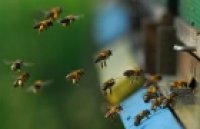| Systematic identification of signal integration by Protein Kinase A |
|
Protein kinase A (PKA) complexes are versatile signaling enzymes controlling homeostasis in eukaryotes. This enzyme is involved in multiple functions under physiological and pathological conditions in humans and governs the virulence of many pathogenic fungi. Here we systematically identify PKA regulators in yeast. Notably, we describe signaling to PKA that involves feedback from the cellular recycling process, autophagy. |
|
Marie Filteau, Guillaume Diss, Francisco Torres-Quiroz, Alexandre K. Dubé, Andrea Schraffl, Verena A. Bachmann, Isabelle Gagnon-Arsenault, Andrée-Ève Chrétien, Anne-Lise Steunou, Ugo Dionne, Jacques Côté, Nicolas Bisson, Eduard Stefan, and Christian R. Landry SignificanceProtein kinase A (PKA) complexes are versatile signaling enzymes controlling homeostasis in eukaryotes. This enzyme is involved in multiple functions under physiological and pathological conditions in humans and governs the virulence of many pathogenic fungi. Here we systematically identify PKA regulators in yeast. Notably, we describe signaling to PKA that involves feedback from the cellular recycling process, autophagy. We also uncover a posttranslational modification, acetylation, that regulates PKA activity in both yeast and mammals, and we show that this mechanism impacts aging. Thus, we identify what regulates PKA as a first step toward the ability to cure diseases and infections, for instance, by providing new candidate genes for drug targeting in health research and antifungals for agricultural and medical purposes. AbstractCellular processes and homeostasis control in eukaryotic cells is achieved by the action of regulatory proteins such as protein kinase A (PKA). Although the outbound signals from PKA directed to processes such as metabolism, growth, and aging have been well charted, what regulates this conserved regulator remains to be systematically identified to understand how it coordinates biological processes. Using a yeast PKA reporter assay, we identified genes that influence PKA activity by measuring protein–protein interactions between the regulatory and the two catalytic subunits of the PKA complex in 3,726 yeast genetic-deletion backgrounds grown on two carbon sources. Overall, nearly 500 genes were found to be connected directly or indirectly to PKA regulation, including 80 core regulators, denoting a wide diversity of signals regulating PKA, within and beyond the described upstream linear pathways. PKA regulators span multiple processes, including the antagonistic autophagy and methionine biosynthesis pathways. Our results converge toward mechanisms of PKA posttranslational regulation by lysine acetylation, which is conserved between yeast and humans and that, we show, regulates protein complex formation in mammals and carbohydrate storage and aging in yeast. Taken together, these results show that the extent of PKA input matches with its output, because this kinase receives information from upstream and downstream processes, and highlight how biological processes are interconnected and coordinated by PKA.
See: http://www.pnas.org/content/112/14/4501.abstract.html?etoc PNAS April 7, 2015; vol. 112 no. 14 4501-4506
Fig. 5. Acetylation regulates PKA in yeast and humans. (A) Sequence alignment of the PKA regulatory subunits. The displayed region contains two conserved (red boxes) and acetylated lysine (red residues) positions. (B) HDAC inhibition using trichostatin A (TSA) (1 µM, 3 h) affects PKA type II complex formation in mammalian cells as quantified using the Rluc PCA (22). Treatment with TSA diminishes complex formation of RII:PKAc, but the RII:RII interaction is not affected. **P < 0.01; Welch’s test. Bars indicate average percent of PPI, and error bars indicate SD; n = 5. (C) Mammalian PKA complex formation decreases by up to 55% and 69% upon PCAF or TIP60 overexpression, respectively. The signal (expressed in relative light units, rlu) was normalized by the expression of either the R (RII-F1) or the C (PKAc-F2) subunit (Fig. S7) and was log transformed. **P < 0.01, *** P < 0.001, **** P < 0.0001; blocked Dunnett’s test. Bars show average log rlu; error bars indicate SD. n = 5. Control, mock treatment. (D) Precipitation of cAMP agarose protein from HEK293 cells transiently overexpressing TIP60 (n = 3) or PCAF (n = 2). Tubulin was used as a negative control |
|
|
|
[ Tin tức liên quan ]___________________________________________________
|


 Curently online :
Curently online :
 Total visitors :
Total visitors :
(22).png)


